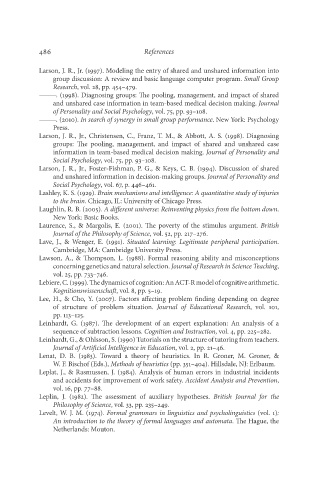Page 503 - Deep Learning
P. 503
486 References
Larson, J. R., Jr. (1997). Modeling the entry of shared and unshared information into
group discussion: A review and basic language computer program. Small Group
Research, vol. 28, pp. 454–479.
———. (1998). Diagnosing groups: The pooling, management, and impact of shared
and unshared case information in team-based medical decision making. Journal
of Personality and Social Psychology, vol. 75, pp. 93–108.
———. (2010). In search of synergy in small group performance. New York: Psychology
Press.
Larson, J. R., Jr., Christensen, C., Franz, T. M., & Abbott, A. S. (1998). Diagnosing
groups: The pooling, management, and impact of shared and unshared case
information in team-based medical decision making. Journal of Personality and
Social Psychology, vol. 75, pp. 93–108.
Larson, J. R., Jr., Foster-Fishman, P. G., & Keys, C. B. (1994). Discussion of shared
and unshared information in decision-making groups. Journal of Personality and
Social Psychology, vol. 67, p. 446–461.
Lashley, K. S. (1929). Brain mechanisms and intelligence: A quantitative study of injuries
to the brain. Chicago, IL: University of Chicago Press.
Laughlin, R. B. (2005). A different universe: Reinventing physics from the bottom down.
New York: Basic Books.
Laurence, S., & Margolis, E. (2001). The poverty of the stimulus argument. British
Journal of the Philosophy of Science, vol. 52, pp. 217–276.
Lave, J., & Wenger, E. (1991). Situated learning: Legitimate peripheral participation.
Cambridge, MA: Cambridge University Press.
Lawson, A., & Thompson, L. (1988). Formal reasoning ability and misconceptions
concerning genetics and natural selection. Journal of Research in Science Teaching,
vol. 25, pp. 733–746.
Lebiere, C. (1999). The dynamics of cognition: An ACT-R model of cognitive arithmetic.
Kognitionswissenschaft, vol. 8, pp. 5–19.
Lee, H., & Cho, Y. (2007). Factors affecting problem finding depending on degree
of structure of problem situation. Journal of Educational Research, vol. 101,
pp. 113–125.
Leinhardt, G. (1987). The development of an expert explanation: An analysis of a
sequence of subtraction lessons. Cognition and Instruction, vol. 4, pp. 225–282.
Leinhardt, G., & Ohlsson, S. (1990) Tutorials on the structure of tutoring from teachers.
Journal of Artificial Intelligence in Education, vol. 2, pp. 21–46.
Lenat, D. B. (1983). Toward a theory of heuristics. In R. Groner, M. Groner, &
W. F. Bischof (Eds.), Methods of heuristics (pp. 351–404). Hillsdale, NJ: Erlbaum.
Leplat, J., & Rasmussen, J. (1984). Analysis of human errors in industrial incidents
and accidents for improvement of work safety. Accident Analysis and Prevention,
vol. 16, pp. 77–88.
Leplin, J. (1982). The assessment of auxiliary hypotheses. British Journal for the
Philosophy of Science, vol. 33, pp. 235–249.
Levelt, W. J. M. (1974). Formal grammars in linguistics and psycholinguistics (vol. 1):
An introduction to the theory of formal languages and automata. The Hague, the
Netherlands: Mouton.

